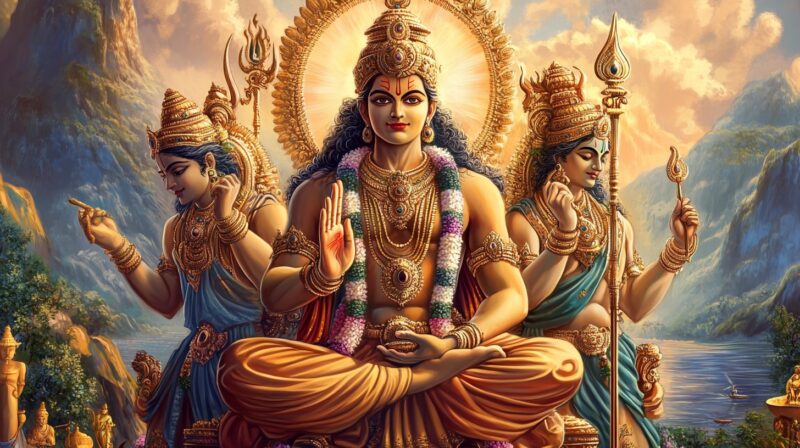Indian mythology is rich with tales of powerful beings and cosmic battles that transcend the earthly realm.
Among these ancient stories are the Adityas, Daityas, and Danavas—formidable celestial entities often depicted as space aggressors and protectors, locked in an eternal struggle for dominance.
These beings, while originating from shared divine ancestry, represent opposing forces in the universe, embodying light and darkness, order and chaos. Through their epic conflicts, Indian legends reveal profound insights into the nature of power, morality, and cosmic balance.
Adityas, Daityas, and Danavas Looked Like People
Despite frequent references to the Adityas, Daityas, and Danavas in ancient Indian texts such as the Vedas, Puranas, and epics, there are surprisingly few detailed descriptions of their physical appearance.
Nevertheless, it is generally assumed, except in the “Rig Veda,” that these beings bore a resemblance to humans.
One striking example comes from the Bhagavata Purana, which vividly describes the aftermath of a battle between the Adityas and Daityas (or their descendants):
“The battlefield was strewn with severed heads of heroes, their eyes still wide open and their lips bitten in a final burst of fury. Earrings and helmets lay scattered among the carnage. Disembodied arms, still clutching various weapons, littered the ground, while legs and hips, resembling the sturdy trunks of elephants, lay amid the chaos. Severed limbs, banners, shattered bows, broken weapons, and torn garments were scattered across the field, painting a gruesome picture of devastation.”
This fragment not only highlights the ferocity of the conflict but also offers a glimpse of the physical might and stature of these warriors, both Adityas and Daityas, with their limbs compared to the massive strength of elephants, further emphasizing their near-mythical status as powerful beings.
Giants with Human Appearance
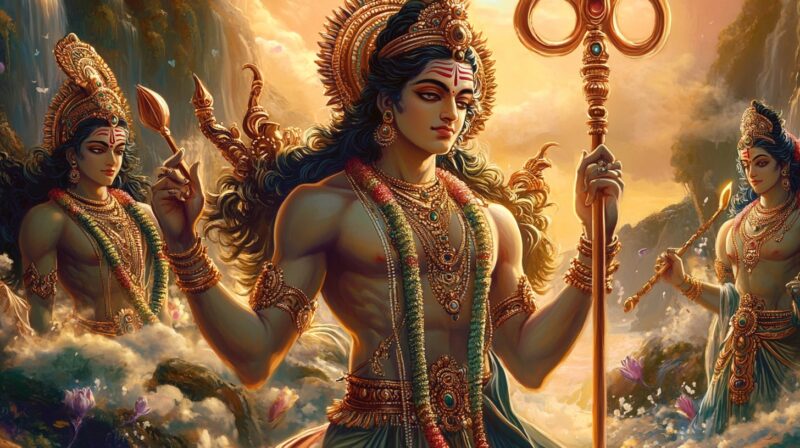
Storytellers often seem captivated by the enormous size of these legendary figures, particularly focusing on their massive legs and hips.
Ancient epics frequently refer to such beings. The Adityas, Daityas, and Danavas, for example, were said to resemble humans in their appearance but possessed vastly larger physiques.
Their size and stature were described as colossal, far surpassing what we associate with modern human proportions.
Indian myths, especially, are rich with accounts of gods, demigods, and demons who not only performed extraordinary feats but also had awe-inspiring physical forms. Their size was as grand as their deeds.
These divine or semi-divine beings often passed on their immense size and incredible strength to their offspring, the heroes of early generations.
Legends paint these first heroes as towering figures, both in height and power, clearly set apart from ordinary humans.
Through these stories, a world is revealed where physical might and grandeur are seen as reflections of divine nature. Heroes and gods were portrayed as standing quite literally above humanity, symbolizing their dominance and superiority.
Beautiful Light-haired White Gods and Demons
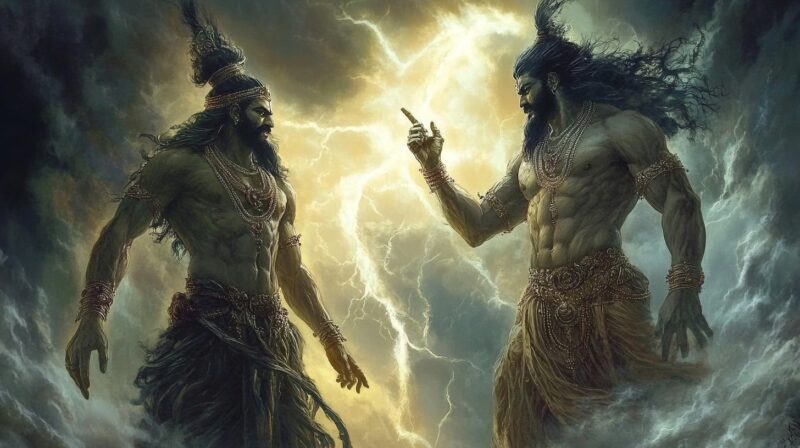
In the Mahabharata, Daityas and Danavas are described as extraordinarily beautiful, with faces “as perfect as the moon.” Their women were portrayed with slender waists and flawless figures, while Aditya women were said to have “teeth of dazzling whiteness” and an almost indescribable beauty. The men of the Adityas were depicted as white gods or demigods, often with light or light-brown hair, reinforcing their otherworldly appearance.
- Indra, the leader of the Adityas, is described as having wide cheekbones, light-red hair, and a beard with whiskers, offering a vivid picture of his divine yet human-like appearance.
- Daityas and Danavas were not only known for their beauty but also their imposing presence, with physical features that set them apart from ordinary humans.
Existing bas-reliefs, statues, and images from the era of early Christianity further support these descriptions. These artifacts add distinct details such as curly hair, whiskers, and beards, often making these gods and demons resemble the heroes of Celtic and Scandinavian myths.
- Indra, Vishvakarman, Mitra, Varuna, and Surya are often depicted with distinct features like curly hair and facial hair, making them reminiscent of mythological figures from other cultures.
- While many of these gods were originally portrayed with light or golden hair, some depictions, particularly of Surya, Hiranyaksha, Hiranyakashipu, and Prahlada, show them with black hair, giving them an appearance similar to Persians or Indians.
This blend of physical traits in different depictions reveals a fascinating cross-cultural influence, showing these divine figures in varying forms that reflect both their divine nature and regional adaptations over time.
Black-skinned Danava-Kalakaeyas

Taraka, also known as Kalanbha, was the son of Daitya or Danava Vadzhranga and is often depicted with black skin. This characteristic likely extended to other Danavas, particularly the Kalakaeyas, who were the descendants of the Danava Vaishvanara.
- The name “Kalakaeya” can be translated from Sanskrit as “black” or “black-dark blue,” which suggests they, too, were black-skinned.
- Ancient texts consistently describe these beings as dark-skinned, reinforcing the association with their name.
- The Kalakaeyas, like many Danavas, were powerful and fearsome, further distinguishing them from other mythological beings through their unique physical traits.
This combination of formidable strength and striking appearance added to their mystique and prominence in the legends.
The Question of Imortaility
Daityas and Danavas lived exceptionally long lives, often surpassing 100,000 years, though they were not immortal like the Adityas. Their lifespans far exceeded human lifespans by an extraordinary margin.
According to the “Bhagavata Purana,” the pregnancy of Diti, mother of the Daityas, lasted around 100 years and was free from the pain of childbirth, a stark contrast to human pregnancy. Given the length of their gestation, Daityas and Danavas were believed to live for 5,000 to 10,000 years or more.
- Longevity: While they lived much longer than humans, Daityas and Danavas had lifespans of tens of thousands of years.
- Birthrate: They typically had one or two children, with three or more being rare, similar to the modern human birthrate.
In the “Matsya Purana,” it is said that Varanga, mother of Daitya or Danava Taraka, carried her child for a thousand years. This suggests that Daityas and Danavas could live up to 50,000 to 100,000 years, depending on their circumstances.
Its longevity is further supported by a passage in the “Vishnu Purana,” where Hiranyakashipu, a Daitya leader, claims to have lived over 100,000 years and spent 60,000 of those years in worship.
- Immortality Attempts: Despite their long lives, Daityas and Danavas sought true immortality. Some leaders, like Hiranyaksha and Hiranyakashipu, were granted blessings from the god Brahma, making them nearly invincible. They could not be killed by any being, weapon, or element, neither by day nor by night.
On the other hand, the Adityas achieved immortality by obtaining the divine nectar, amrita. According to ancient Indian epics, they lived perpetually, although even these texts acknowledge that nothing in the universe lasts forever—not even the life of Brahma, the Creator, which is said to span 311 trillion human years.
- Immortality: Adityas, through amrita, were considered immortal, but the concept of true immortality is nuanced in Indian mythology, where even the longest lives eventually come to an end.
Superhuman Capacities of Daityas and Danavas
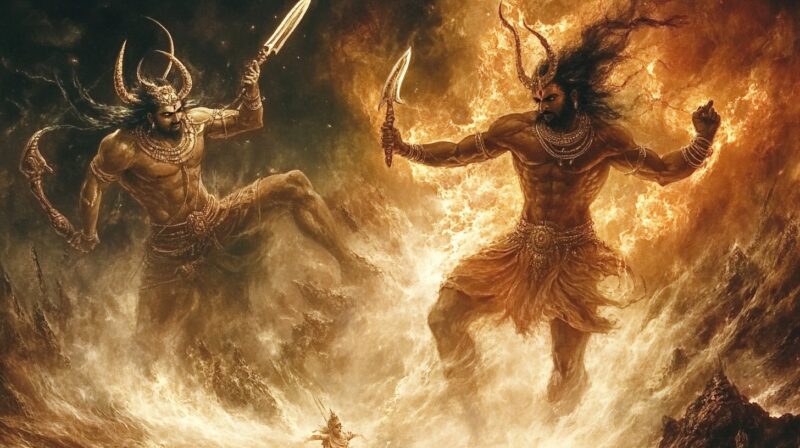
In addition to their extraordinary longevity, the Daityas and Danavas were endowed with numerous “superhuman” abilities.
According to Indian legends, they were not only wise and cunning but also masters of magical arts, known as maya. This allowed them to alter their appearance and take on various forms.
- They could transform into humans, or assume “frightening forms of enraged elephants, lions, and tigers,” much like the Rakshasas.
- Additionally, they could become invisible, much like the mystical Nagas.
The descendants of these powerful beings inherited their magical abilities as well. One notable figure, Bala, the son of the skilled artist and architect Maya Danava, was said to possess 96 types of mystical powers.
- Hiranyakashipu, the sovereign of the Daityas, used his gift of invisibility to seize the throne of Indra and wreak havoc on the gods’ dominions. His mastery of mystical abilities, or siddhis, made him a formidable force capable of destroying the universe itself.
Moreover, Ushanas, the chief priest and guru of the Daityas, also possessed great powers. He and his beloved, Dzhanti, were able to remain invisible to the outside world for a hundred years, a testament to the incredible mystical abilities these beings wielded.
These stories illustrate the vast and dangerous powers of the Daityas and Danavas, positioning them as more than just physical giants, but also as beings capable of manipulating reality through their supernatural abilities.
Daityas and Danavas Used Magic in Battles
Indian legends are filled with references to the Daityas and Danavas employing magic during battles.
To illustrate this, here are two examples drawn from the Mahabharata and the Bhagavata Purana:
“In this battle demons [Daityas and Danavas] were beaten and, to escape (save themselves) from death, they took advantage of magic and with its help had slayed a great number of the soldiers combating on the party of demigods [Fdityas]. Demigods, without seeing another escape, had again given up themself to the Sovereign Person of God Vishnu which, coming, counteracted against the illusions created by tricks of demons.”
“Then in the sky there were the terrible clouds driven by violent winds. Peals of thunder rattled and the shower of heated coals had poured down on land .
The gigantic fire organized by daitya Maharadzha Bali, incinerated the troops of demigods. This fire attended by frantic gusts, was as well awful as Samvartaka fire which are originated in the cycle of destruction of the Universe. Everywhere there were swirls and gigantic sea waves, foamed by furious gusts, and in the face of all the deluge has started. When the invisible demons possessing skill of making of look-alike illusive mirages, have transformed the battle field into such fantastic chaos, demigods have become despondent “.
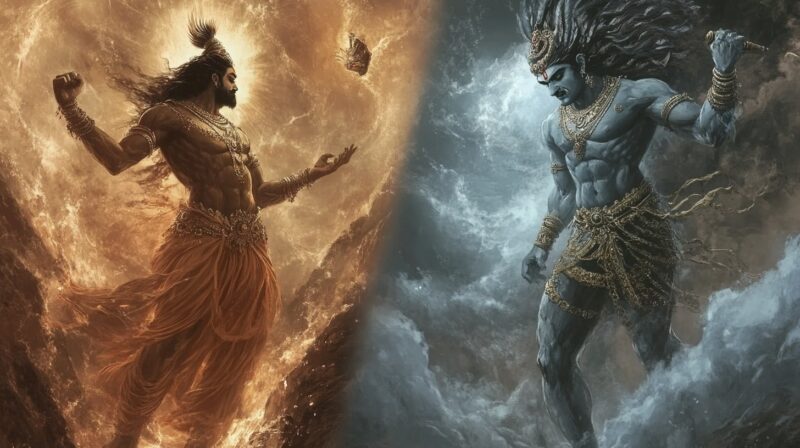
Everyday life of Daityas and Danavas
The Vishnu Purana mentions that the children of Daityas and Danavas received an education, by attending something similar to schools.
In the Mahabharata, it is said that among the Daityas and Danavas, there were learned individuals, such as the earth king Abhiru, poets like Daitya Vaishvanara, and noble rulers such as Brihat, Ashoka, and Samudrasena.
These leaders were known for their dedication to prosperity and universal welfare, suggesting that the Daityas and Danavas had a sophisticated society focused on intellectual and cultural achievements.
- Education: The youth of the Daityas and Danavas attended schools where they were taught knowledge and skills, similar to how human societies educated their young.
- Cultural Contributions: There were scholars, poets, and kings among the Daityas and Danavas who worked for the betterment of their people and the world.
However, another side of their society is revealed in the same texts. The brothers Hiranyakashipu and Hiranyaksha, sons of Diti, practiced extreme austerities and penances that lasted for hundreds or thousands of years. When they returned to the city of the Daityas, they indulged in earthly pleasures, feasts, and luxury.
Their people followed their example, and soon, their entire land was plunged into decay, darkness, and devastation.
- Moral Decline: Despite the initial prosperity and intellectual pursuits, the indulgence in excessive pleasures by the ruling class led to the moral and societal decay of the Daitya and Danava civilization.
- Uncertain Timeline: It remains unclear whether these events occurred simultaneously across different regions or if they were separated by millennia.
Superhuman Capacities of Adityas
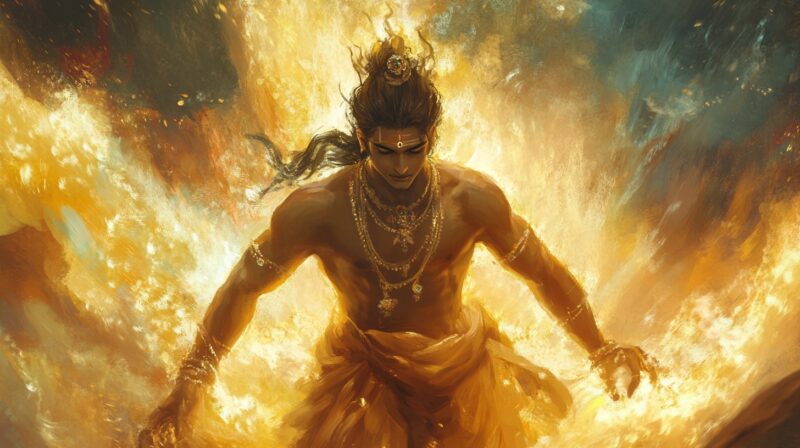
Did the Adityas possess the same “superhuman” abilities as the Daityas and Danavas? While the Indian epics and Puranas do not explicitly confirm this, certain details suggest that the Adityas had similar powers.
- Some legends hint that the Adityas, like the Daityas, could shape-shift into various animals. For example, when the Daityas and Danavas ruled the world, they permitted the Adityas to walk the Earth only in the form of monkeys.
- The Adityas likely also possessed the power of invisibility and mastery over Maya—the ability to create illusions.
The fact that the Adityas are not frequently portrayed as magicians or sorcerers could be explained by the intent of ancient storytellers to “whitewash” the gods and demigods.
In this way, the Adityas were presented not only as powerful beings but also as protectors of righteousness, with their abilities cloaked in a more favorable light compared to the Daityas and Danavas.
If you want to read about what we know about Hyperborea from ancient books and old maps, you can do so now.
Flying vehicles of Daityas and Danavas
One of the most remarkable characteristics that set the Adityas, Daityas, and Danavas apart from other inhabitants of Earth—both before and after their time—was their mastery of space travel and the use of flying vehicles and orbital space stations.
These advanced technologies were widespread and served a variety of purposes, ranging from intergalactic journeys to flights within Earth’s atmosphere.
Indian legends provide detailed accounts of two master designers of these orbital space stations. Maya Danava, a skilled artist and architect of the Danavas (and in some versions, of the Daityas), and Vishvakarman, the architect of the gods (Adityas or Devas), were key figures in the construction of these spacefaring structures.
- Maya Danava was revered as an acharya (teacher) of all magical practitioners capable of harnessing mystical forces. His creations included not only ordinary cities but also flying cities, which could soar through the skies or beyond.
- Vishvakarman, on the other hand, was credited with designing and constructing incredible vehicles and structures for the gods, including space stations and otherworldly crafts.
These flying cities and vehicles, often described in vivid detail in ancient texts, highlight the extraordinary technological prowess of these ancient beings. Their ability to navigate space and operate advanced craft differentiates them from most other beings in Earth’s ancient history, underscoring their connection to the divine and the mystical.

